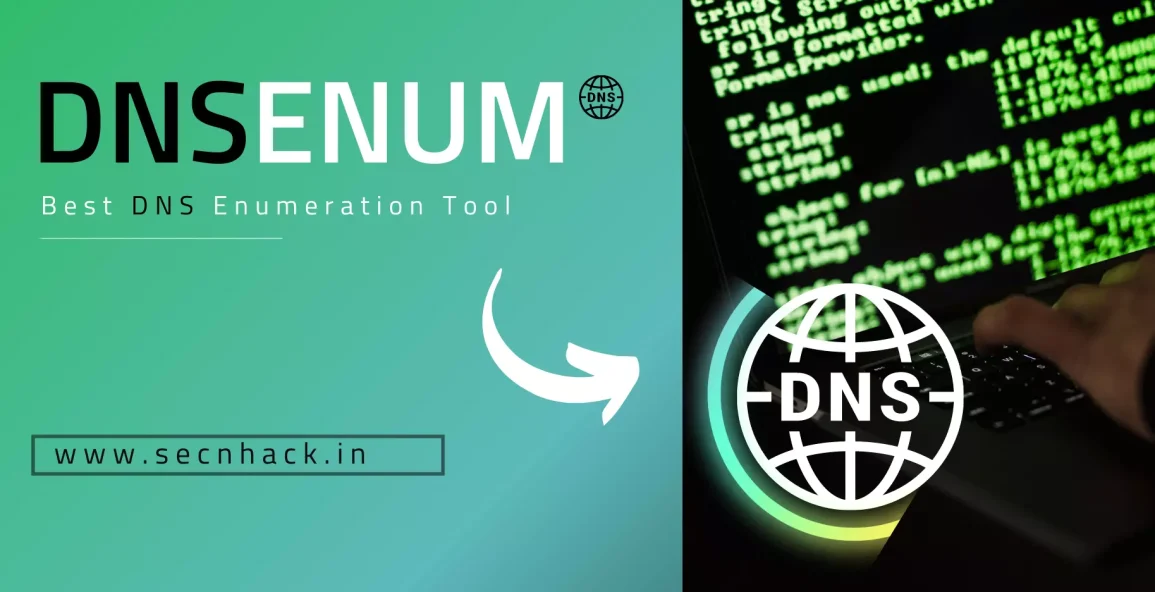
Introduction to DNSenum
DNSenum is a robust tool for enumerating the DNS (Domain Name System) in penetration testing and cybersecurity applications. It is essential for acquiring domain information, such as identifying DNS servers, hostnames, and IP addresses. DNS enumeration is one of the first steps in penetration testing and reconnaissance because it helps security experts or ethical hackers understand the target’s network infrastructure and potential entry points for exploitation.
The DNS protocol converts human-readable domain names (such as example.com) into IP addresses, which computers use to communicate. Attackers or penetration testers frequently use DNS misconfigurations or vulnerabilities to acquire sensitive information that can be used in subsequent assaults, such as identifying subdomains, hosts, or services that may not be properly secured. DNSenum is widely regarded as one of the most effective tools for performing DNS reconnaissance operations.
What is DNS Enumeration?
Before delving more into DNSenum, it’s vital to grasp the concept of DNS enumeration. DNS enumeration entails obtaining DNS-related information about a domain. The method usually involves retrieving DNS records, such as:
- A records map domain names to IPv4 addresses.
- AAAA records map domain names to IPv6 addresses.
- MX records identify mail servers that receive emails on behalf of a domain.
- NS records: Name server records that specify which DNS servers are authoritative for the domain.
- PTR records are pointer records for reverse DNS lookups.
- Canonical name records (CNAMEs) are used for domain aliasing.
- Text records are commonly used to provide additional information such as security policies (e.g., SPF, DMARC).
This technique assists testers in understanding the digital assets connected with a domain, how they are structured, and whether any exposed systems or services might be exploited for future attacks.
DNSenum: Overview
DNSenum is a Perl-based utility that automates the process of acquiring DNS information and is included in several penetration testing suites, including Kali Linux. It is especially useful in large networks where there may be several subdomains and external resources, making manually enumerating each DNS record cumbersome.
DNSenum allows penetration testers to easily discover numerous hosts linked with a domain, extract DNS records, and check for zone transfers, which occur when DNS servers are misconfigured and allow the entire flow of DNS data. This type of information could be a goldmine for attackers because it reveals internal and external systems, subdomains, and services.
Features of DNSenum
DNSenum is a feature-rich tool designed to gather critical DNS-related information. Below are some of the core features of DNSenum:
- Subdomain Enumeration
DNSenum enables users to locate subdomains linked with a specific domain. Subdomains may represent distinct services (e.g., mail.example.com, api.example.com, vpn.example.com) with differing levels of protection, and attackers might acquire network access through weaker entry points.
- Reverse DNS Lookups
DNSenum can do reverse DNS lookups on a set of IP addresses to find the matching domain names. This is especially useful when studying large networks when direct access to DNS records is limited or incorrect.
- WHOIS Lookup
DNSenum has WHOIS lookup capabilities for obtaining information about the domain owner, registration dates, and contact data. This information can be useful during reconnaissance, as well as understanding how long a domain has been in existence and who is in charge of managing it.
- DNS Server Identification
One of DNSenum’s primary functions is to find DNS servers that are authoritative for the domain. By discovering these servers, ethical hackers might identify potential vulnerabilities, such as DNS poisoning or server misconfigurations, which could lead to additional assaults.
- Brute Forcing DNS Records
DNSenum may brute force DNS records by using external tools such as dnsrecon or bespoke wordlists to find probable subdomains and domain-related services. This
strategy is effective when traditional procedures do not produce enough results.
Use Cases of DNSenum
1. Penetration Testing.
DNSenum is a fundamental reconnaissance tool for penetration testers, allowing them to obtain information about the domain’s infrastructure. Identifying DNS servers, subdomains, and exposed services is critical for understanding a target’s attack surface.
DNSenum is also useful for determining whether DNS zone transfers are misconfigured, which is a serious vulnerability that could disclose critical internal network information.
2. Network Mapping.
DNSenum maps out a domain’s digital footprint by identifying IP addresses and associated hostnames. This is critical for knowing how different services interact and which systems are connected to the internet.
Network mapping is vital not just for offensive security, but it also helps to improve defensive posture by identifying any neglected or incorrectly configured resources.
3. Security audits.
DNSenum can be used by organizations to undertake internal security audits, ensuring that their DNS infrastructure is properly setup and that no sensitive information is being exposed needlessly.
The application can also assist firms in maintaining compliance with various security standards (such as PCI DSS or ISO 27001) by constantly checking their DNS settings and flagging any potential security flaws.
4. Bug bounty programs
DNSenum is extensively used by bug bounty hunters looking for vulnerabilities in website or service DNS configurations. Bug bounty hunters may detect security weaknesses that lead to unauthorized access or sensitive data exposure by discovering subdomains or misconfigured DNS records.
For example, if a bug bounty hunter discovers a forgotten subdomain that still refers to an old web application, it could be exposed to SQL injection or remote code execution.
DNSenum Commands:
- dnsenum -h
This command is used to assist in discovering more uses for the dnsenum tool. This help command provides information on how to use dnsenum.
- dnsenum zonetransfer.me
This command is used to retrieve the specifics of a specific domain name and fetch information such as host addresses, servers, MX servers, and IP addresses for the hostnames.
- dnsenum hackthissite.org
This command is the same as the last one, except the hostname is different: ‘hackthissite.org’.
- dnsenum –private hackthissite.org
This command is mostly used to view the private addresses associated with the specified hostname. In addition to the private address, we can have various subdomains.
- dnsenum — noreverse -o mydomain.xml google.com
This command is used for non-reverse domain addresses associated with the hostname. The “-o” command refers to the output file format, and the destination here is the current working directory. The format provided here will be “xml”.
- dnsenum –whois hackthissite.org
This is a general command that takes information about “who” is logged into the hostname and displays the IP addresses of those individuals in the console.
- sudo dnsenum — enum -f “/usr/share/doc/dnsenum/dns.txt” salesforce.com
This command is used for enumeration, which implies that the collection of commands provided by dnsenum will be compressed into a single location. We can also see that the “dns.txt” file has a list of all the keywords that can be used against the set of commands used to search for the hostname.
- sudo dnsenum -p 5 -s 5 — threads 2 google.com
This command combines three instances: -p, -s, and -threads. Each instance has different functionalities. Here, -p refers to the pages that are available for the specific hostname. Next -s refers to Google scraping, which is also used to capture URLs from webpages. Finally, -threads refers to the hardware-specific command line that is used to accelerate the process dependent on CPU settings.
